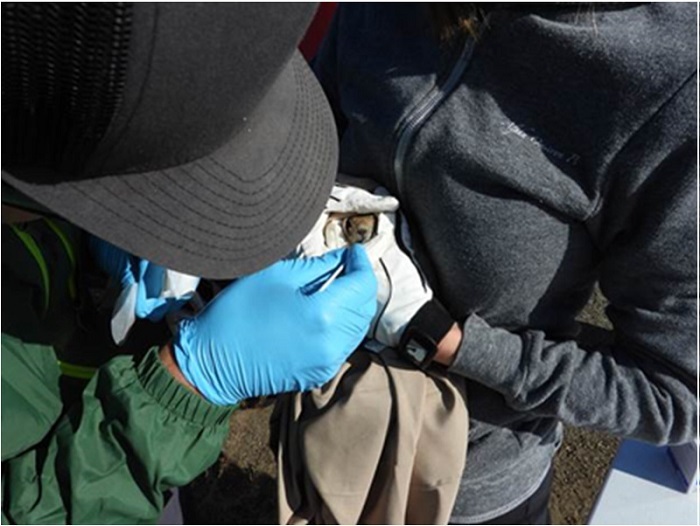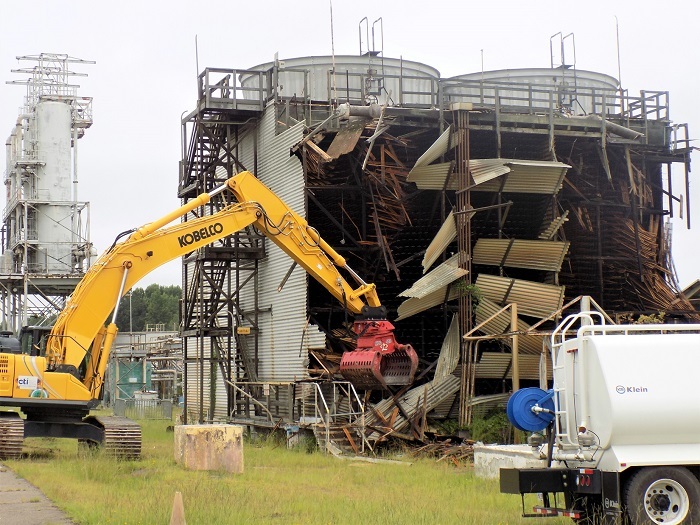 EM workers demolish a large industrial cooling tower built in 1952 at the Savannah River Site.
AIKEN, S.C. – EM and the management and operations contractor at the Savannah River Site (SRS) have torn down a large industrial cooling tower built in 1952, part of more than 85,000 cubic feet of waste and scrap material removed from the site’s D Area complex.
Made of fiberglass, steel, and wood, likely from cypress trees, the tower was constructed over a large concrete basin to remove heat from water used to generate steam in a nearby powerhouse. During the Cold War, D Area facilities extracted heavy water from the Savannah River for use in SRS reactors.
“Working closely with our subcontractor, this demolition task was completed inexpensively, ahead of schedule, and without a safety incident,” said Kelsey Holcomb, a project manager with Savannah River Nuclear Solutions (SRNS). “One of the few remaining steps is to remove 70 years worth of debris out of the concrete basin itself, where water accumulated before being pumped back to the powerhouse.”
Crews also removed two large motors and fans on top of the tower installed to draw cooling air across cascading water within the structure.
The 3,800-square-foot tower stood about 50 feet tall. Its large concrete foundation reached seven feet in depth to form the water-filled holding basin.
SRNS awarded the cooling tower demolition subcontract to CTI and Associates, which has conducted the majority of deactivation and demolition work in D Area over the past year.
CTI is an SRNS mentor-protégé company. The SRNS Mentor-Protégé Program is a DOE initiative designed to help small businesses enhance their capabilities as subcontractors across the DOE complex. The SRNS program includes the Mentor-Protégé Center of Excellence, where mentor companies share best practices and lessons learned.
“CTI continues to impress us with their performance, including meeting, and often exceeding, our safety and quality-of-work requirements,” Holcomb said. “SRNS requested that this project be accelerated, and CTI ensured that the task was safely and effectively accomplished as asked.”
CTI is set to demolish additional structures this year, helping to further reduce EM’s footprint at the 310-square-mile site. So far, 89% of EM’s footprint has been removed there.
“In the near future, we are scheduled to have a total of 34 structures removed from D Area. The completion of the D Area closure project will result in a significant footprint reduction for the site,” Holcomb said. “Our goal is to return every waste site at SRS to a more natural state, which also reduces associated maintenance and environmental surveillance costs. Project by project, we’re continually learning how to better treat area closure sites.”
-Contributor: DT Townsend
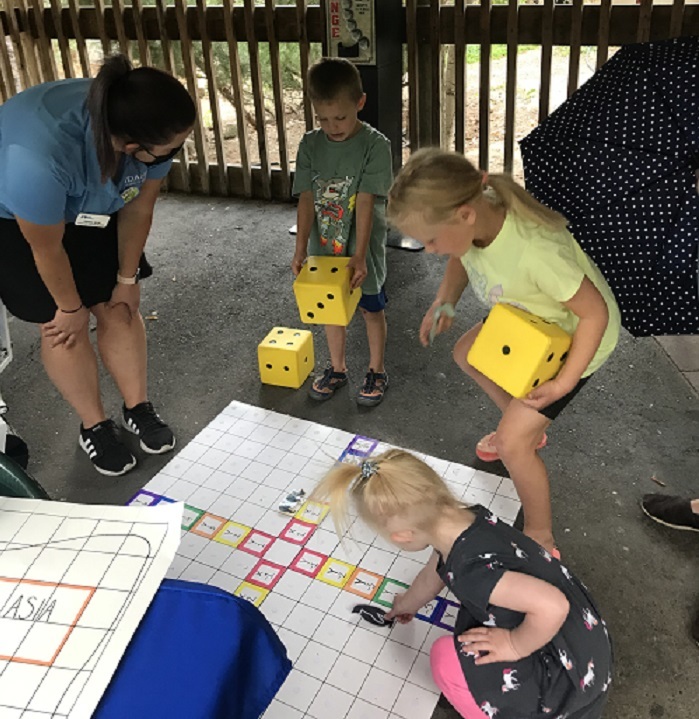 Fluor Idaho, EM’s contractor at the Idaho National Laboratory (INL) Site, sponsors Family STEAM Day at the Zoo. Each science, technology, engineering, arts, and math (STEAM) station at the event is designed to stimulate the interest and creativity of students. Here, Trisha Mick, a community education specialist with Idaho Public Television-Boise, teaches students the basics of math coordinates such as plotting points. The students used this exercise to determine where their favorite animal was located at a theoretical zoo.
IDAHO FALLS, Idaho – More than 1,250 students who visited the Idaho Falls Zoo in 2021 were treated to a bonus: the opportunity to learn more about science, technology, engineering, arts, and math (STEAM).
Fluor Idaho, EM’s contractor at the Idaho National Laboratory (INL) Site, was the primary sponsor of Family STEAM Day at the Zoo, which catered to the science and art interests of eastern Idaho students.
Due to the COVID-19 pandemic, the usual two-day annual event, which has attracted more than 1,800 students in the past, was expanded to three separate events in May, August, and September.
“We did small STEAM Day events to keep it smaller and safer this year,” said Augusta Grumdhal, education coordinator for the zoo. “We’re hoping to do the two-day event next spring.”
Students were treated to activity stations on skulls and pelts, foil boat building, catapult building, a sheep brain, human circuitry, art projects, a math activity that required the use of coordinates to find specific areas of the zoo, identifying animal tracks, and using math to determine how much food certain animals at the zoo must eat.
New to this year’s event was a silent art auction to raise money for the Gorongosa National Park in Mozambique, which Westside Elementary School fifth graders were reading about in class. The money raised will help fund education, research, and conservation efforts at the park.
Grumdhal said the event was not just beneficial to the national park, but also to the students’ social development.
“Students who were auctioning their art also had to address the audience, which helped with their public speaking skills,” she said.
The silent art auction raised $575.
Family STEAM Day at the Zoo is one of the most popular events that Fluor Idaho sponsors each year as part of its education and community initiatives.
-Contributor: Erik Simpson
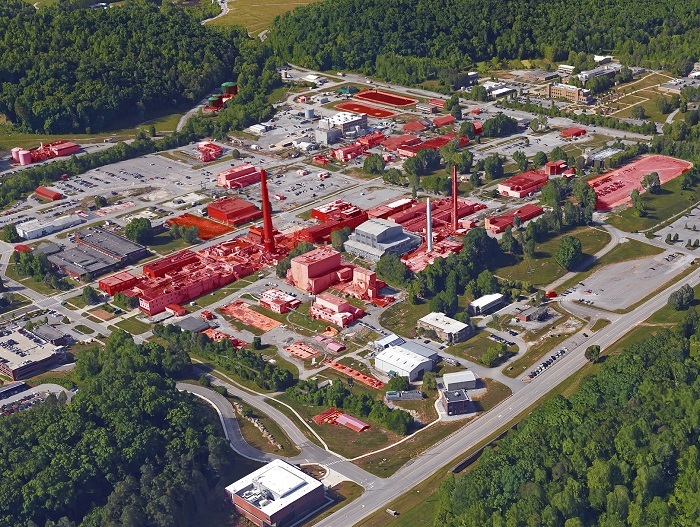 A view of the central campus area at Oak Ridge National Laboratory (ORNL), which houses the oldest buildings at the laboratory. Buildings slated for EM cleanup are highlighted in red. Crews are performing deactivation at 18 ORNL facilities.
OAK RIDGE, Tenn. – EM workers are in various stages of deactivation and demolition preparation inside 23 facilities at Oak Ridge National Laboratory (ORNL) and the Y-12 National Security Complex (Y-12), including former research reactors, uranium processing facilities, isotope and fission development laboratories, and support buildings.
The projects represent a significant step toward enhancing safety, advancing cleanup, and clearing land of deteriorating infrastructure to expand the missions of the research and national security sites. ORNL and Y-12 house hundreds of excess, contaminated facilities that make up the largest inventory of high-risk buildings in the DOE complex.
Prior to deactivation and demolition preparation at the facilities — 18 at ORNL and five at Y-12 — employees conduct significant planning and documentation. That includes developing plans for characterizing and removing waste from the facilities. Engineers also create plans to isolate electrical and mechanical energy hazards in the buildings, such as power, water, and natural gas lines.
Characterization involves marking and sampling throughout the facilities to determine the presence and levels of any contaminants. That data informs the Oak Ridge Office of Environmental Management (OREM) and its cleanup contractor, UCOR, of appropriate safety measures for employees preparing the buildings for demolition.
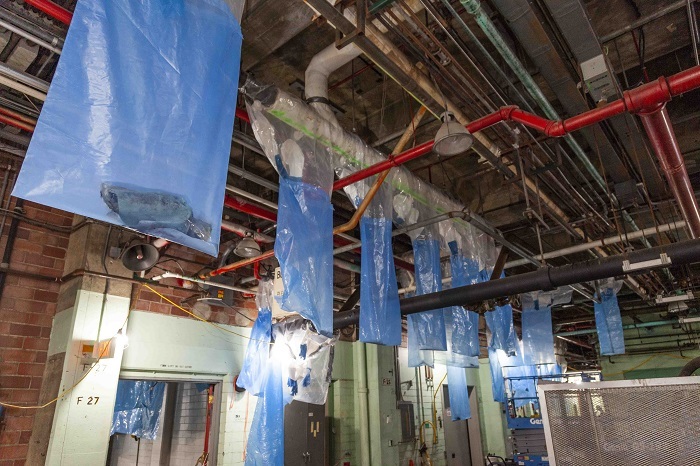 EM crews pre-staged and hung bags throughout the Beta-1 facility at the Y-12 National Security Complex before removing asbestos-containing materials. This approach allowed them to work steadily to remove the materials instead of stopping and resuming the cleanup to obtain additional bags.
UCOR Oak Ridge Reservation Environmental Cleanup Manager Dan Macias said the company’s successful deactivation and demolition at the East Tennessee Technology Park (ETTP), which was completed last year under budget and ahead of schedule, provided a roadmap for the work ahead.
Workers who supported the ETTP project are using their training and experience to successfully complete projects at ORNL and Y-12, and they are identifying innovations and efficiencies along the way.
“When we wrapped up demolition at ETTP, we were able to bring those highly-trained deactivation workers over to ORNL and Y-12. Their expertise makes it possible for us to work in the most efficient way,” Macias said. “They have also come up with some great ideas for ways to continue our work even with the resource challenges we have occasionally experienced due to the pandemic.”
Employee innovation led to increased efficiency in asbestos removal, a significant step in the deactivation process for many old buildings in Oak Ridge. Crews at Y-12’s large Beta-1 facility pre-staged and hung bags used to collect asbestos-containing materials throughout the facility. This allowed them to work steadily to remove the materials instead of stopping and resuming the cleanup to obtain additional bags.
-Contributor: Susanne Dupes
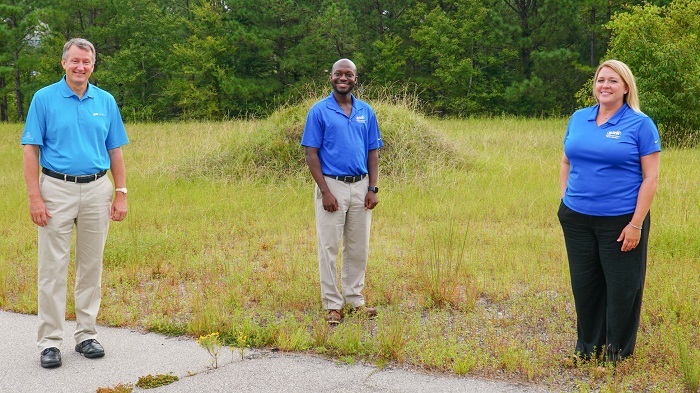 From left, Savannah River Remediation (SRR) President and Project Manager Phil Breidenbach stands with SRR Defense Waste Processing Facility Engineer Frank Armstead and SRR Senior Recruiter Allison Brinkley. Armstead and Brinkley helped create the Technical Student Program, which allows select students to stay employed with the liquid waste contractor to complete training and work while still in college following their internships at the Savannah River Site.
AIKEN, S.C. – EM has created a new program in the liquid waste contract at the Savannah River Site (SRS) to simplify the process of transitioning engineering interns into new hires.
Many science, technology, engineering, and math (STEM) students have jump-started their careers at SRS through summer internships with Savannah River Remediation (SRR) since the company began its liquid waste contract at SRS in 2009.
Now, SRR is retaining more interns who are good matches for the company using the Technical Student Program (TSP). It allows select students to stay employed with SRR after their internships to complete training and work while they are still in college.
As they work toward finishing school, the students remain part-time employees of SRR, reducing the time it takes to become SRR-qualified engineers from one year to six months. Once the students become full-time employees, they can obtain additional qualifications.
The TSP provides students with a clear path from summer internships to engineering positions, according to Frank Armstead, an engineer at the site’s Defense Waste Processing Facility who helped create the initiative.
“This program has three main goals: reduce the time it takes for new hires to obtain facility-specific qualifications, allow engineers to gain experience through mentorship, and provide SRR with a pipeline of talent that has the right training to take on high-demand engineering functions,” Armstead said.
Four students are currently pursuing STEM degrees in the TSP. Connor Hess, a senior mechanical engineering major at the University of South Carolina, said he looks forward to gaining work experience in the engineering field.
“This program has a lot of great aspects,” Hess said. “I’m getting an early start on my career while taking essential job training, learning from experienced engineers, and getting paid while I’m still in college.”
The program does more than just improve the hiring process; it allows students to fully integrate into the team at the onset of their careers, providing substantial benefit to the students, SRR, and EM, SRR President and Project Manager Phil Breidenbach said.
“Savannah River Remediation’s core values of safety, integrity, ownership, teamwork, and continuous improvement are instilled into students early through their internships and the Technical Student Program,” Breidenbach said. “I’m eager to see these students combine their classroom and internship knowledge as they work to successfully execute our mission.”
-Contributor: Lindsey Kennedy
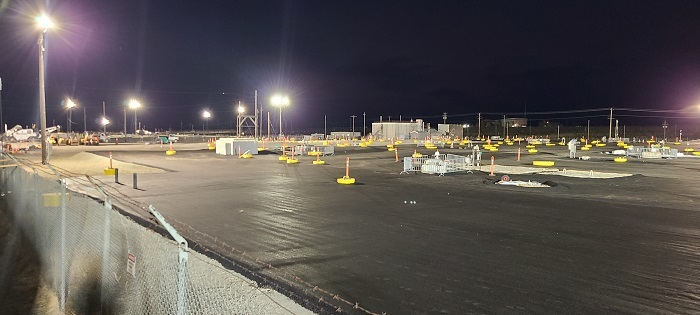 A new surface barrier in Hanford’s TX Tank Farm protects the environment by preventing rain and snowmelt from seeping into the soil and mobilizing any existing contaminants.
RICHLAND, Wash. – Workers have finished installing another surface barrier above a group of large underground waste storage tanks at the Hanford Site. The gravel and asphalt barriers help protect groundwater by diverting water from rain, snow, sleet, or hail to a lined basin.
“The water evaporates instead of permeating into the soil and driving existing contaminants closer to groundwater,” said Becky Blackwell, EM Office of River Protection (ORP) program manager for the barrier installation project. “The protective covers also reduce our costs for surveying and maintaining what was once a soil and gravel surface.”
In February, ORP contractor Washington River Protection Solutions (WRPS) awarded a subcontract to local firm Fowler General Construction to install three sections of high-density asphalt to form one large barrier over the 18 tanks that make up the TX Tank Farm.
Crews used about 4,000 tons of gravel and 6,000 tons of asphalt to construct the barrier that consists of a layer of gravel covered with four inches of compacted, high-density asphalt. Each 758,000-gallon tank in the TX Farm is 75 feet wide, and the barrier covers about 220,000 square feet — an area larger than four football fields.
In addition to protecting the groundwater beneath the tanks and reducing costs for surveying and maintaining the ground surface, the protective covers provide other benefits.
“The surface barriers also improve the stability of the tanks and the surrounding soil, and they provide a clean and stable platform for field crews while they work in the tank farm,” said Jim Geary, WRPS tank farm projects manager.
The surface barrier was constructed under an agreement between DOE, the Washington State Department of Ecology, and U.S. Environmental Protection Agency.
-Contributor: Mark McKenna
|


